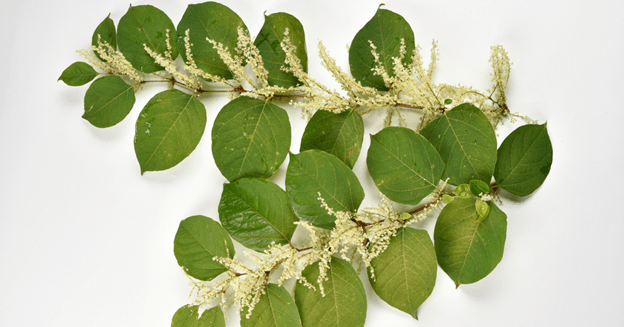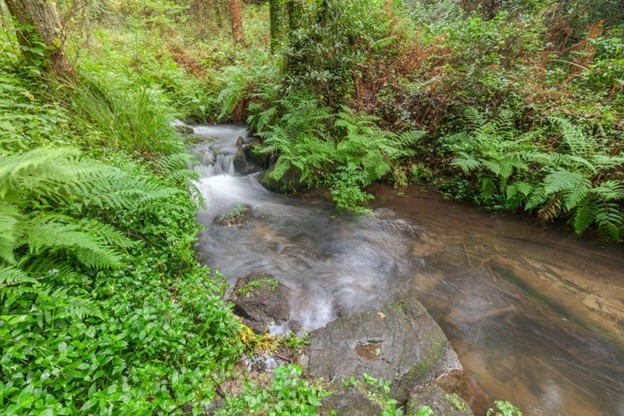Imagine adding an exotic, charming plant in your garden just for it to bulldoze over everything in your yard! This happened to American gardeners when they planted Japanese knotweed, a weed many New England homeowners now struggle with.
Reaching heights upwards of 10 feet and evading the effects of drought or heat, Japanese knotweed is a common New England weed that doesn’t mess around. It’s bigger than crabgrass, tougher than dandelion, and won’t go away with a quick pull. Here’s how to stop Japanese knotweed from taking over your lawn.
What Does Japanese Knotweed Look Like?

At first glance, you might notice that Japanese knotweed is quite beautiful (of course, Americans’ desire to own it is why it ended up here in the first place). However, you won’t be impressed once you find out how fast it takes over.
The perennial is shrub-like in appearance, but don’t be fooled. Its roots are runners, meaning the plant can sprout from dropping seeds and by spreading its roots underground. With large, lush leaves and white, spike-shaped flowers, Japanese knotweed gets mistaken for a stunning garden plant all the time. It can also be identified by these features:
- Long, hollow, woody stems that look similar to bamboo
- Produces white flowers from August to September
- Smooth, alternating leaves 4-6 inches long
- Tends to grow in moist soil near riverbanks or streams
Where Is Japanese Knotweed Invasive?
If you’re local to us, chances are this pesky plant is in your neighborhood! Since its introduction to North America by British gardeners in the 19th century, Japanese knotweed wasted no time making itself at home in the Northeast. We’ve found Japanese knotweed in our service locations, including Connecticut, Massachusetts, and Rhode Island. Eventually, it made its way to the Pacific Northwest, spreading through local yards like wildfire.
Why Is Japanese Knotweed So Bad for Massachusetts Lawns?

Simply put, if there’s a will, there’s a way! Japanese knotweed will spread wherever there’s room. The more it grows, the harder it is to get rid of. This feature makes it a lawn-suffocating plant and a challenge for homeowners to tackle.
As the shoots spread, they steal nutrients from the soil to become stronger and bigger, leaving your lawn weak and stressed. Japanese knotweed loves the competition (and most of the time, it wins). Your lawn doesn’t want to share resources with any weeds because it needs nutrients like nitrogen to grow thick and weed-resistant. Additionally, its large leaves and tall height block sunlight from hitting patches of your grass, making it even harder to keep your lawn healthy. Ample sunlight is essential to photosynthesis, the process by which your grass makes food using sunlight. Without enough sun, your lawn will become thin and fragile, leaving it susceptible to fungal growth and pests.
How To Get Rid of Japanese Knotweed
Warning: This isn’t your average weed removal job. Japanese knotweed requires hardcore spring weed control to be removed forever. A combination of chemical and manual efforts works best. Japanese knotweed rapidly spreads through its fast-growing roots, so cutting them off is the first step to stopping its invasion. While removing this weed takes several months, it’s the best way to ensure your yard stays knotweed-free.
Step 1: Cut down the stems.
- Chop the stems short before the plants flower.
- Repeat this several times per year.
- Don’t throw the cuttings in your compost! Burn them or bag them – this guarantees the plant won’t re-root.
Step 2: Apply an herbicide.
- Spray or paint glyphosate on the remaining cut stems.
- Be cautious of your surrounding lawn; it won’t survive contact with herbicide.
These two steps will slowly starve out roots, even if it takes months of continuous, careful work.
Here’s what you should never do: pull the plant out by the roots. Japanese knotweed is one tough cookie. Any small root fragments left in the soil can regrow into a new plant like a hydra!
Tackle Weeds With Ease: Let Our Experts At Mission Green Do It!
A little shrubbery has never scared us away from a challenge! Don’t wrestle with weeds alone – let us help you finish the job. Contact our experts at Mission Green today for a FREE quote on weed control services in MA, CT, and RI.



